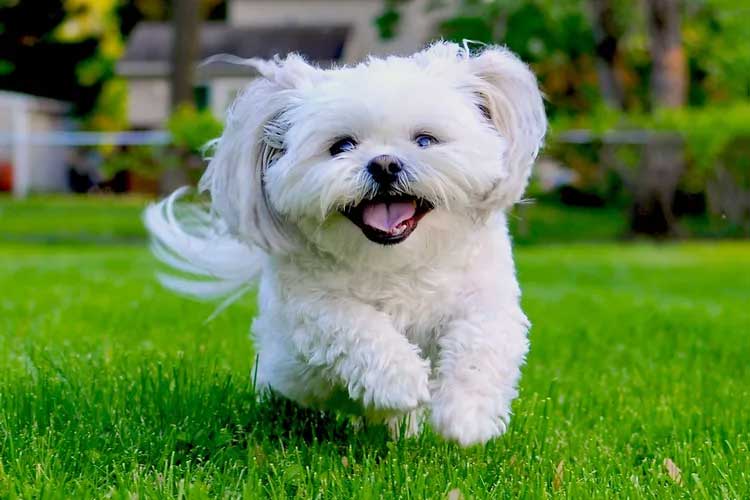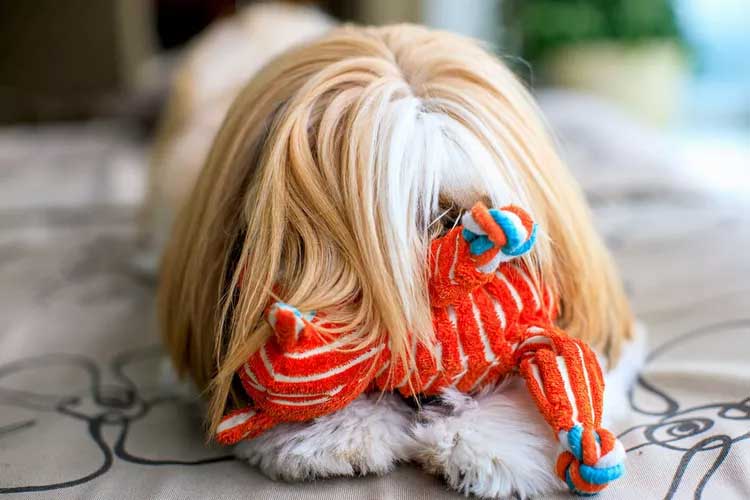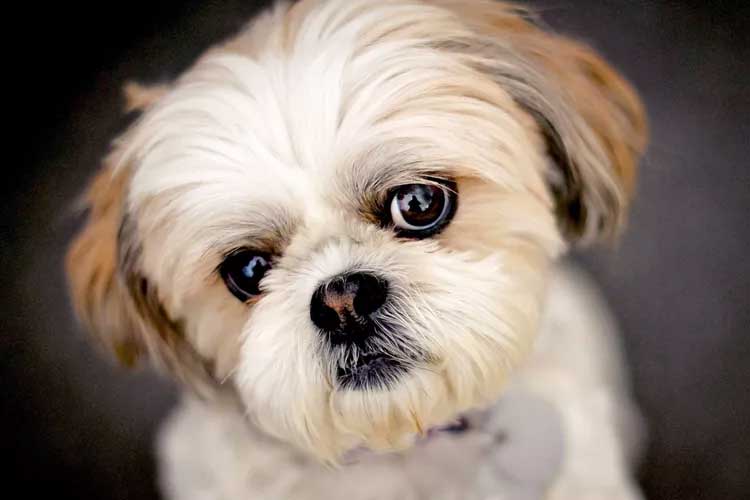
Shih Tzu Overview
| OFFICIAL NAME | Shih Tzu |
| COMMON NAME | Shih Tzu |
| PET HEIGHT | 9 to 10 inches |
| PET WEIGHT | 9 to 16 pounds |
| LIFESPAN | 10 to 18 years |
| GOOD WITH | cats, children, dogs, families, seniors |
| TEMPERAMENT | friendly, outgoing, playful |
| INTELLIGENCE | high |
| SHEDDING AMOUNT | normal |
| EXERCISE NEEDS | low |
| ENERGY LEVEL | calm |
| VOCAL LEVEL | frequent |
| DROOL AMOUNT | low |
| BREED GROUP | toy |
| BREED SIZE | small (0-25 lbs.) |
| COAT LENGTH | long |
| COLORS | black, blue, brown / chocolate / liver, gold / yellow, red, white |
| PATTERNS | bicolor, brindle |
| OTHER TRAITS | apartment-friendly, good for first-time pet owners, high prey drive, requires lots of grooming |
With a name to make you chuckle—it's actually pronounced "sheed-zoo" or "sheet-su"—the shih tzu is a perennially popular dog breed, especially for those seeking a pet with good looks. Their long, beautiful coats and adorable faces turn heads everywhere they go, and shih tzus delight in the attention. But they aren't just easy on the eyes; these pups will tug at your heartstrings, too. Shih tzus are very loyal and dish out lots of affection for their owners. They have literally perfected the role of lap dog for more than a thousand years.
Their name translates to "little lion"—a nod to their ancient Chinese heritage, but a misnomer for the gentle pooch—and they also have a whole host of other nicknames: "under-the-table dog," "Fu dog," "shock dog," "sleeve dog," "Tibetan poodle," and the "chrysanthemum-faced dog" thanks to their unique facial fur, which has the appearance of flower petals.
A shih tzu is happy and playful, but will demand quite a bit of your attention—and make sure you provide it. "They can be sweet and kind or yappy and naughty," says Pam Nichols, DVM, President-elect of the American Animal Hospital Association. "They are generally happy and are way better behaved when they are well socialized." Their friendly attitude and regal looks, coupled with their adaptability to even the smallest living spaces, make them a very popular companion.
Appearance
The shih tzu is a sturdy toy breed, weighing anywhere between 9–16 pounds. They are best known for their long, silky, luxurious double coat, which can be found in 14 different colors—including black, black and white, gray and white, and red and white—and three different markings. Most shih tzus also have a small white spot on their foreheads, called the "Star of Buddha," which is highly prized.
Shih tzus do have unique smiles, thanks to their undershot bite. A shih tzu's lower jaw is just wider than the upper jaw, so their upper teeth bite inside the lower teeth when their mouth is closed. And the hair on their faces grows in every direction, including up from their snout, and must be groomed often so it doesn't hang in front of their eyes.
Because of their royal heritage—Chinese royalty kept these dogs as companions—a shih tzu carries itself with great pride. Some say they are even a bit arrogant in their gait: Head held high and tail curved over the back.
Temperament
The way to a shih tzu's heart is lavish attention. And they are never happier than when perched on your lap. Bred as a friendly companion—no hunting, herding, or guarding instincts exist—shih tzus simply want to be near their owners. And while they may initially bark at new humans, shih tzus make quick friends with everyone they meet. Between their gorgeous appearance and their look-at-me-and-love-me demeanor, they command attention everywhere they go. It's no wonder so many people are drawn to their companionable personality.Living Needs
Shih tzus are loving and charming with all family members. They are especially affectionate and docile with children if trained properly. As with any breed, make sure to socialize your shih tzu and ensure the kids in your household know how to handle these small pups so they have a happy relationship. Kids need to take care not to carry her around or poke her prominent eyes.
Shih tzus coexist peacefully with cats and other dogs. And because they were bred to spend the day within the walls of a palace, shih tzus are ideal for apartment dwellers or other homes without a lot of outdoor space. As long as they can be near their owner, shih tzus are happy anywhere.
Given their lavish coat and the flat shape of their face, shih tzus are susceptible to heat stroke, so make sure you have a place for them to cool off when temperatures rise. They're happy to bask in the breeze of a fan and definitely appreciate air conditioning. Shih tzus coats also keep them from being good swimmers, so don't expect them to jump into water to cool down.
One frustrating quirk to keep an eye on is the shih tzus propensity to eat their own (or other animals') feces. Don't let it become a habit. Watch your pup closely while on walks or at the dog park, and clean up her poop right away.
Because they adore their owners so much, shih tzus love to be carried around. But ensure you hold them securely—they tend to be front heavy—and don't let them jump. They tend to try to jump off furniture as well, which can lead to injuries, including concussions.
Care
Beauty is demanding, and it's definitely true when it comes to keeping your shih tzu's coat looking its best. To prevent tangles, bathe your pup weekly and brush (and comb) her hair daily. Starting when she's a puppy—so she gets used to grooming—teach your shih tzu to lay on her side while you brush her hair in sections. Opt for a wire brush with flexible pins so you can brush all the way to her skin. Shih tzu puppies have fluffy fur, but at about a year old, their coat will become silky. Some owners choose to have a groomer give their shih tzu a shorter haircut to lessen the amount of time spent on primping. Thankfully, they are low shedding.Her nails should also be trimmed monthly and you'll need to check her ears for dirt, redness, odor, or the occasional hair that grows inside the ear canal—this will need to be plucked.
You'll also spend time cleaning up your shih tzu's face. Much like a messy toddler, their faces get dirty when they eat and their eyes tear up often. They can also be prone to tear stains, where the hair around their eyes turns a rusty hue. Keep them clean by wiping their faces with warm water and a soft cloth. Another way to keep their eyes from being irritated is to pull the hair on top of their head into a top knot. Shih tzus appreciate the look.

Because your shih tzu was bred as a house companion—and they have short little legs—they only require minimal exercise. They are happy with a short daily walk or some dedicated indoor playtime. You'll find them wandering the house, playing with toys, and certainly racing to greet anyone at the door.
While it's tempting to tote your pup with you all the time, it will impact your shih tzu's behavior. "Because of their small size, they tend to get carried around and not be trained as much so it's hard to know whether they are very biddable." Nichols says. She and other experts recommend crate training, which can be especially helpful when you travel with you shih tzu. Remember to be consistent, patient, and use positive reinforcement when training any dog.
They can be difficult to housebreak—it may take up to 50 repetitions to get the potty routine just right—and will likely need to be supervised indoors for some time. Don't let the little charmer have her way, but do shower her with positive feedback for a less frustrating experience.

Health
These pups are generally healthy, but as with any breed there are some typical health conditions you should be aware of. Shih tzus do sometimes deal with ear infections, hip dysplasia, patellar luxation (a slipped kneecap), umbilical hernias, and a portosystemic liver shunt (a congenital abnormality in which blood vessels allow blood to bypass the liver). But don't worry: All of these issues are treatable.A shih tzu may not lose her baby teeth before her permanent teeth come in, which may require a trip to the vet for extraction. Because the breed has an undershot jaw, they can also have missing or misaligned teeth. With a shih tzu puppy, you may deal with a lot of snuffles, snorts, and loud snoring as she teethes. As she gets older, she may suffer from reverse sneezing—a wheezing sound made when she's overly excited—gulp her food too quickly, or encounter an allergen.
Her prominent eyes can also give her trouble, including cataracts, progressive retinal atrophy, retinal detachment, and corneal dryness. Eyes can also become inflamed from excessive air exposure due to improperly closing eyelids. Reach out to your vet right away if you notice any issues with your shih tzu's eyes.
History
Digging into the history of the shih tzu is like taking a mini lesson in east Asian history. According to the Shih Tzu Club, this breed dates back at least 1,000 years, with records of "under the table" dogs appearing in China all the way back to 8,000 B.C. It's believed they were originally bred in Tibet—some say by Tibetan monks—and the tiny dogs were sent to the Chinese emperors as gifts. It's believed the Chinese then bred them with Pekingese and pugs or Lhasa apsos to create the shih tzu we know today.Other legends abound when it comes to shih tzus' royal heritage. It's reported that in the 13th century Marco Polo discovered that Mongolian Emperor Kublai Khan kept small "lion" dogs, believed to be shih tzus, with trained hunting lions to keep them calm. (It's worth noting that Pekingese is also called "lion dog" in Chinese.) There are records of the Chinese royal family keeping shih tzu-like dogs during the Ming Dynasty (1368–1644) as well.

In 1861, the shih tzu gained even more status thanks to Empress Dowager Cixi of China. She had a true love for animals and spent much time breeding them. During her reign, it's said she was gifted, by the Dalai Lama, a pair of spectacular shih tzus who lived in their own palace and were trained to sit up and wave when the Empress arrived. When Empress Cixi died in 1908, shih tzu breeding came nearly to a halt, almost causing extinction.
Shih tzus were long hidden behind palace walls and only really introduced beyond Asia—first in England and Ireland—in the late 1920s and early 1930s. The breed made its way to the U.S. two decades later and was recognized by the AKC in 1969.
Fun Facts
Folklore says Buddha traveled with a little dog believed to be a shih tzu. One day while they were traveling, robbers approached Buddha and the little dog transformed into a ferocious lion, caring off the robbers and saving Buddha's life. The lion turned back into the little dog, which Buddha picked up and kissed. Many shih tzus have a white spot on their heads that's said to mark the spot of Buddha's kiss.When shih tzus were facing extinction, seven males and seven females were used to rebuild the breed. Today, every shih tzu can be traced to those 14 dogs.
Long popular in China and Europe, shih tzus were brought to the U.S. in the 1940s and 1950s by American soldiers stationed in Europe.
Shih tzus are popular with royalty and celebrities alike. Notable shih tzu owners include Beyoncé, Bill Gates, Mariah Carey, and Nicole Richie.